There are three species of coniferous trees known as redwoods: Giant Redwood (or Giant Sequoia), Coast Redwood and Dawn Redwood. The Lake Wilderness Arboretum’s Woodland Garden has all three.
Giant Redwood (or Giant Sequoia)
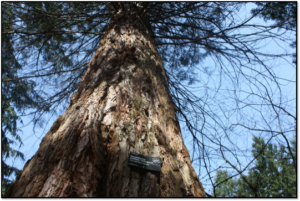
A Giant Redwood in the arboretum
The Giant Redwood (Sequoiadendron giganteum) is also referred to as a Giant Sequoia and occurs naturally only in groves on the western slopes of the Sierra Nevada Mountains of California. The Giant Redwood is the world’s largest single tree growing to an average height of 165-280 feet and 20-26 feet in diameter. Record trees have been measured at over 300 feet in height.
Coast Redwood
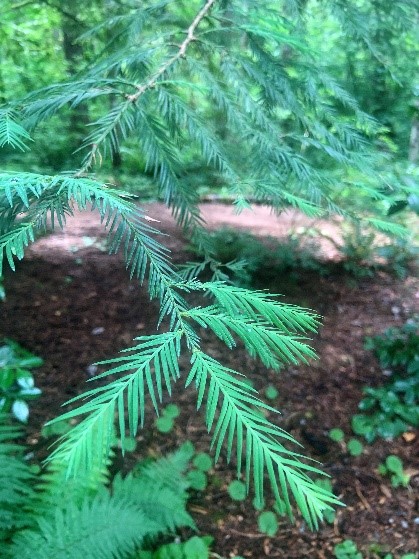
The leaves of a Coast Redwood 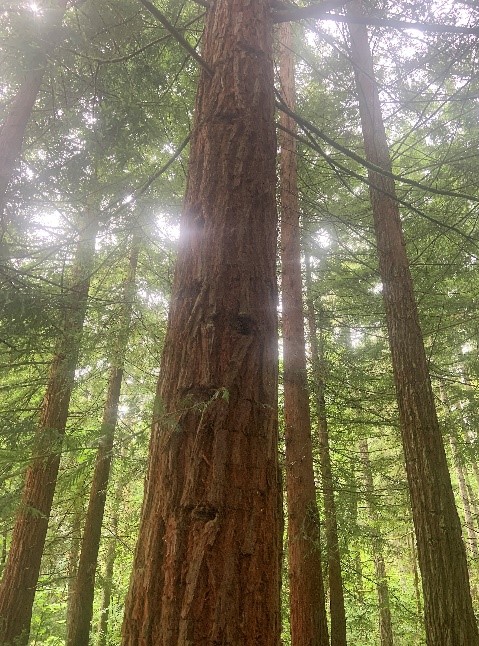
Coast Redwoods in the arboretum 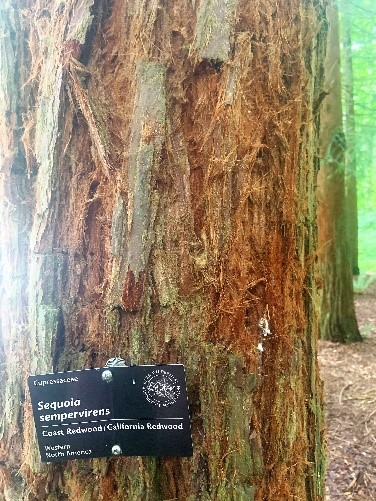
The bark of a Coast Redwood
The Coast Redwood (Sequoia sempervirens) is so named because it is native to moist, foggy, coastal areas along the Pacific coast, now being primarily confined to a narrow coast belt extending from southern Oregon south to the San Francisco Bay area, which is why it is also referred to as the California redwood. In this native habitat, it is a magnificent, long-lived tree that is generally considered to be the tallest tree in the world, growing to 350’. Although fast-growing in its native habitat, it still may take 400+ years for a redwood to reach maturity. But it can live to 2000 years or more. These trees are among the oldest living things on Earth. In cultivation outside of its native habitat (like here at the Lake Wilderness Arboretum), it will grow much smaller, typically to 60-90 feet tall. The Coast Redwood along with its close cousin Giant Redwood (Sequoiadendron giganteum) are jointly designated as the State Tree of California.
You can spot the coast redwoods planted at the western end of the Woodland Garden because of their bright-red brown bark that is soft and fibrous. The narrow-conical, evergreen conifer features flat, bright green needles and oblong seed cones. It is a prized lumber tree for its rot-resistant wood that is straight-grained and knot-free.
Dawn Redwood
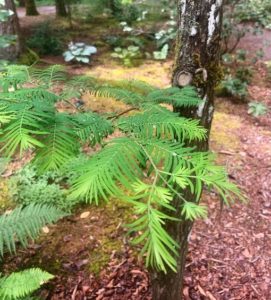
If you grew up believing that deciduous trees are trees with broad leaves that drop their leaves in the fall and that coniferous trees are evergreen trees with fine needles, you might be surprised to learn that this is only partially correct. This common description, often found in grade-school textbooks, may be accurate, but it doesn’t tell the whole story.
Most trees and shrubs fall into one of two categories: deciduous or coniferous. The deciduous trees have leaves that fall off yearly. Coniferous trees bear cones and have needles or scales that do not fall off. Another common name for these conifers is evergreens, although not all evergreens are actually conifers (i.e. some tropical trees and shrubs).
There are about 20 species, however, that straddle both worlds and are dubbed deciduous conifers. These trees form cones and sprout needles like conifer trees, but they also change colors in the fall and lose their needles every year like deciduous trees.
Dawn redwood (Metasequoia glyptostroboides) is one of these trees. A huge, deciduous conifer that can grow to a mature height of up to 150 feet, with a trunk diameter of more than 8 feet it is characterized by a pyramidal habit, peeling, reddish bark, and deciduous needles, about 1/2-inch long. A native of the Sichuan and Hubei provinces in west-central China, dawn redwood grows in sunny sites with well-draining soil or soggy soils.
Of the five genera of deciduous conifers (Larix, Metasequoia, Psuedolarix, Taxodium and Glyptostrobus), three can be found in the Lake Wilderness Arboretum’s Legacy Garden and the Metasequoia is also located in the Woodland Garden.
